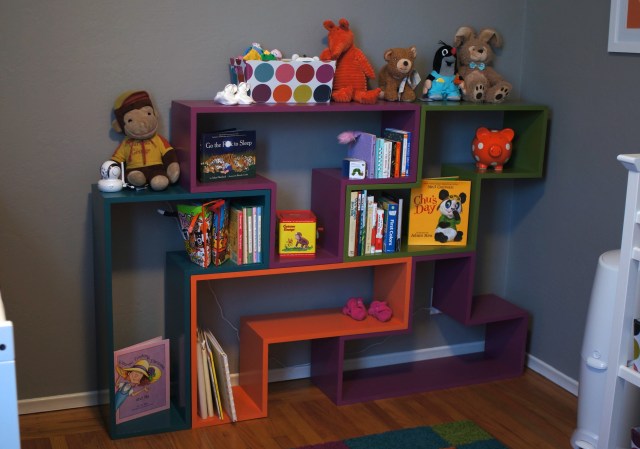Sorry for the break unexpected break gang. My daughter was born the week after the last installment, and just as I was starting to recover, I got sick and was out of commission for a few more weeks. Everything’s groovy now though, and I’m ready to wrap up the build log on my first project of 2013, a set of modular Tetris shelves for my baby’s room. If you’re just joining us now, you should probably check out part 1 and part 2 before you read this.
When we last left off, I’d successfully assembled five Tetrominos, using biscuits, glue, and square clamps to join everything together. At this point, I was pretty sure that the hard part was done, and all I had left was a little bit of painting and sanding. I couldn’t have been more wrong.
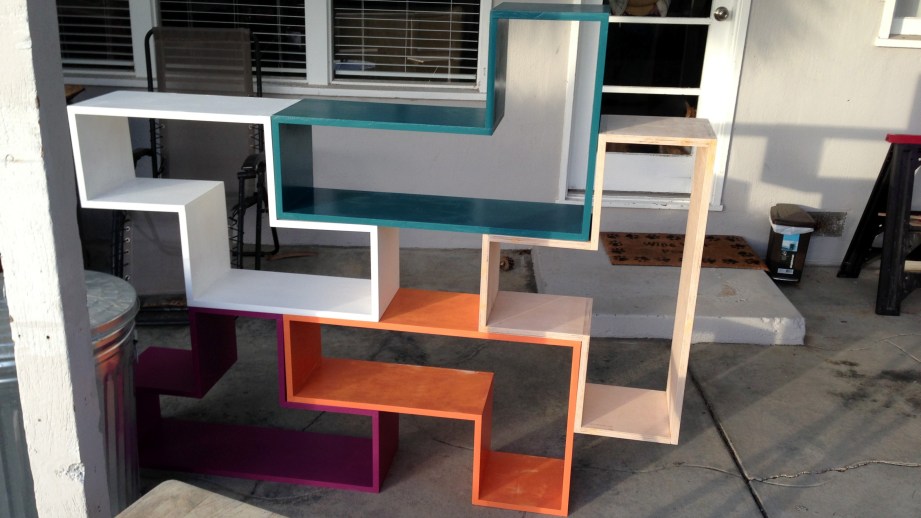
Sanding Really Sucks
For a project like my shelves, sanding serves two purposes. It was important to smooth over any rough edges where my board cuts were slightly off. Typically these little mistakes amounted to edges that were just fractions of an inch off, but the effect was jarring. Any place that the boards didn’t perfectly line up, I sanded until the joints were smooth. I also made sure to sand down any places where glue had dripped or the board edges had burned during my initial cuts.
This is where an orbital sander is extremely handy. My orbital sander–a cheap Black & Decker model–uses a quarter-sheet of sandpaper and allowed me to remove material much more quickly than I could by hand. I experimented with different grit sandpaper, remembering that lower grit numbers are more coarse and will remove excess material more quickly, and found that 150 grit was great for sanding down edges that didn’t meet, while 220 or 300 were better for sanding the surfaces and edges of boards.
There were also a handful of joints with particularly bad overlap. To take the excess wood off of those joints faster, I used a rasp. A rasp is basically a cheese grater for wood. Once the offending pieces almost lined up, I also needed to sand the surface of each piece before priming to ensure a clean surface for primer adhesion.

The entire time I was removing material, I was cognizant of the fact that it’s very easy to remove too much material and very difficult to restore material once sanded. Whether I was rasping or sanding, I was careful to remove a bit, check my seams, and then remove more if needed.
All told, the first sanding pass took between 20 and 30 hours to complete all five pieces. The sanding was absolutely backbreaking work, but the finished shelves would have looked crummy had I not taken the time to sand them properly. Sanding both allowed me to fix any minor flaws and cover any mistakes I had made while assembling the shelves.
As a warning–I did a fair amount of my sanding inside, but I used a respirator mask to block particulate the entire time I was working. I also coated everything in my garage with a fine layer of dust because I was cheap and didn’t buy the Shop-Vac attachment for my sander. As a result I’ll have to spend a weekend in the near future dusting the entire garage–not fun. The difference between a good sander with a vacuum attachment and the one I have is so great that the next time I need to sand anything substantial, I’ll probably pony up for a new sander and the adapter.
Priming
After consulting the helpful professional at my local paint shop, I bought a gallon of Zinsser B-I-N Primer from Home Depot for my first coat. Why use primer? Well, there were two reasons. Using a primer designed for use on new wood reduced the number of coats of paint I needed to finish the shelves. It also has a high particulate count, which help fill in the handful of gaps that I found in the side of the thin-ply I used to build the shelves. By using the primer, along with a little wood filler, I was able to avoid having to add veneers to the cut edges of the plywood, which saved me a ton of time. If I was doing this over again, I’d have had a light grey tint added to the primer–in its pure white form, it required two coats of the thinner colors to cover the white. Had I bought the paint from a real paint shop instead of Lowe’s, I would have been able to get a slight tint added the primer, which may have helped get decent coverage with the first coat of paint.
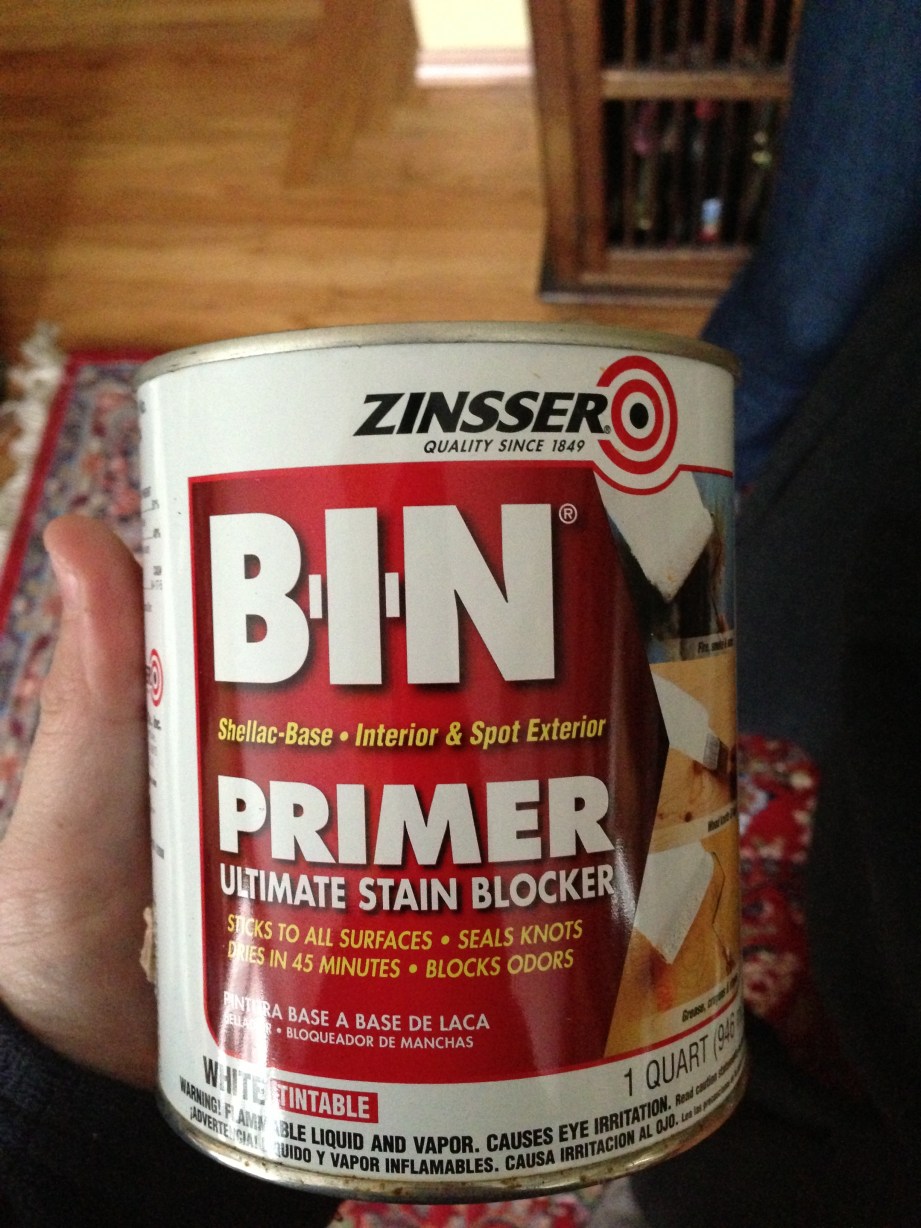
Applying the primer is just like painting–except instead of paint, you’re applying a viscous colloidal suspension of particles and a stinky water base. First, I wiped the entire shelf with a damp rag, to remove the last traces of the dust from the first sanding pass. After the shelves dried, I used a 2.5-inch brush to apply a liberal coat of primer to every side of the shelves, starting with the top piece. It seems like the best way to avoid drips and weird corners was to skip every other face, then come back and finish the unpainted faces after the rest of the paint had dried. To do the last side, I rested the shelf on two pieces of scrap wood, then let it dry for at least 2 hours, but preferably more. Then, it was time for more sanding.
I used a finer grit sandpaper on the primer than I did when sanding the naked wood. The goal when sanding the primer was to smooth any rough patches I’d inadvertently added when I applied primer. After some experimentation, I found that 220 or 300 grit paper on the orbital sander did a good job taking off rough spots without removing too much of the primer.
Aside from a handful of spots I missed, I was done priming. I wiped off the sanding dust from each piece with a damp rag, and was ready to paint.
Painting
Because these shelves were going in my kid’s room and I don’t have a good place to let them air out, I wanted to stay away from paint that would need a long time to dry away from people. Even though it isn’t the best paint for furniture, I ended up going with a glossy latex paint. I was able to put it in the baby’s room after a day or two of drying, and if she scrapes chunks of paint off it isn’t the end of the world.
As I wasn’t exactly sure how well the latex paint would work on furniture, I didn’t want to spend a ton of money on it on the chance it didn’t work. With that in mind, I bought quarts of Valspar from Lowes and of each color I needed. I matched the colors by bringing stuff from home that was the colors I wanted and comparing it to the many thousands of color swatches at the store.
I used a couple of nylon brushes to do the actual painting, both 2-inch and 3-inch versions, making sure to avoid drips. After a fair amount of experimentation, I found that painting adjoining surfaces was a surefire way to mar fresh paint, so I switched to painting alternate edges.
Unfortunately, because I was using bright colors of paint, I needed to apply at least two coats of paint to every shelf. That did give me the opportunity to fix a few rough patches and drips that happened while I was painting. A few moments with some fine grit sandpaper were enough to fix the mistakes.
The Finished Product!
After a few days in the garage to give the paint plenty of time to dry, it was time to set the shelves up. I originally thought I was going to have to add a sealant to them in order to prevent sticking when they were attached to each other, but when the paint was fully dry, I didn’t have any serious sticking problems. The arrangement my wife and I chose for the layout gives us plenty of shelf space and leaves each piece both well supported and locked into place. I do need to tether the shelf to the wall, but I can do that with a pair of screws and some inexpensive nylon webbing.
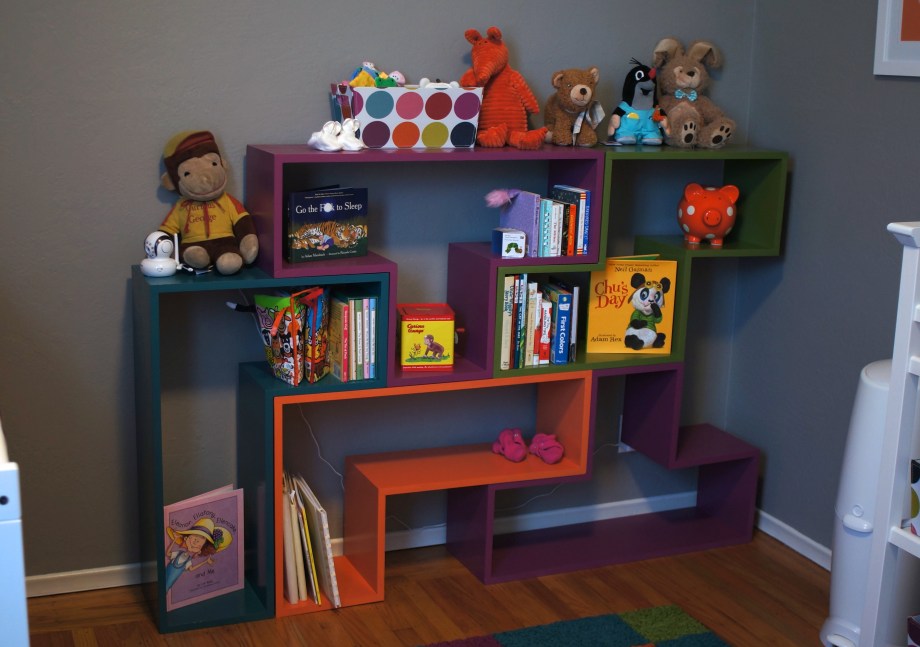
All told, I spent about $700 on the shelves–$220 on wood, $200 on clamps, $60 on tool rentals, $50 on saw blades, $60 on paint and primer, $30 on sandpaper, and another $50 on assorted small tools and consumables (mostly glue and biscuits). About half of that was on tools, tool rentals and other stuff I’ll be able to use again in the future–at least if I ever have a project that requires 16 corner clamps again. It took me somewhere between 60 and 80 hours of work to complete the shelves, spread out over a month or so. I guess it’s kind of a cliche, but I was surprised that finishing the shelves too much longer than actually assembling them.
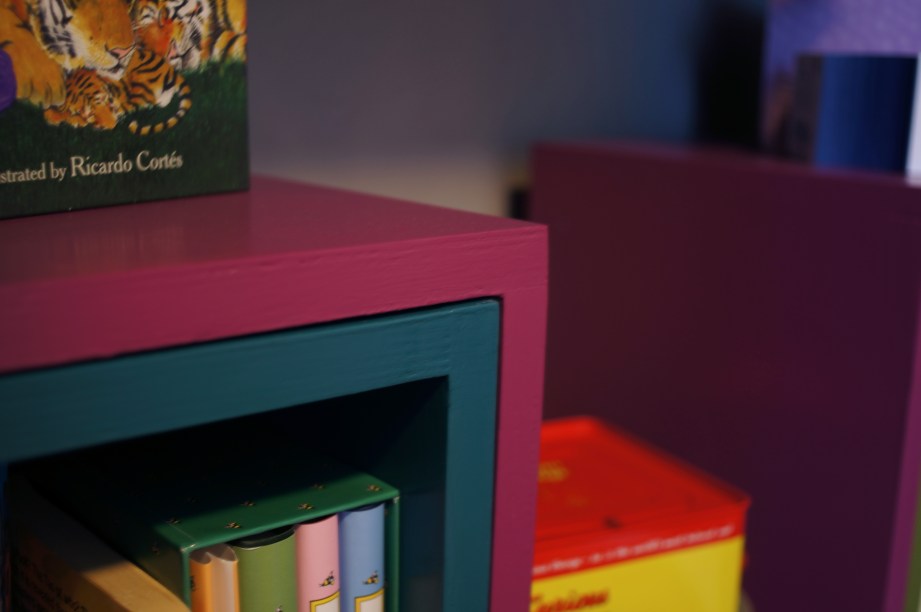
The shelves turned out much better than I thought was possible. They actually look like they were made by someone who knows what they were doing. The individual piecesjoin up properly at the seams much better than I anticipated, so the individual pieces look like one unified piece of shelving when they’re assembled. My careful measurements and all those corner clamps really paid off as the good fit saved me from having to make either of the mechanisms I designed to affix the shelves to each other.
I wish I built enough pieces to take the shelves all the way to the ceiling. Knowing what I do now, I’d pay a wood shop to break down the plywood sheets for me and rent a sprayer to prime and paint the shelves, which would save me a ton of time. I’m carpentered out for the time being though. Maybe I’ll build the rest when she’s old enough to help, if she’s into them.






